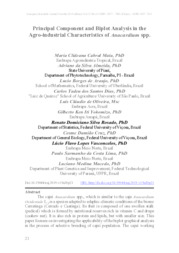Principal component and biplot analysis in the agro-industrial characteristics of Anacardium spp.
Principal component and biplot analysis in the agro-industrial characteristics of Anacardium spp.
Author(s): MAIA, M. C. C.; ALMEIDA, A. da S.; ARAUJO, L. B. de; DIAS, C. T. dos S.; OLIVEIRA, L. C. de; YOKOMIZO, G. K. I.; ROSADO, R. D. S.; CRUZ, C. D.; VASCONCELOS, L. F. L.; LIMA, P. S. da C.; MACEDO, L. M.
Summary: The cajuí Anacardium spp., which is similar to the caju Anacardium Ocidentale L., is a species adapted to edaphic-climatic conditions of the biome Cerratinga (Cerrado e Caatinga). Its fruit is composed of one swollen stalk (pedicel) which is formed by nutritional reserves rich in vitamin C and drupe (cashew nut). It is also rich in protein and lipids, but with smaller size. This paper focuses on investigating the applicability of the biplot graphical analysis in the process of selective breeding of cajuí population. The cajuí working population in Embrapa Meio Norte comprises of 11 genotypes collected in areas of natural habitat in the state of Piaui. The experiment was designed in randomized complete blocks with two plants per plot and four replications. A graphical analysis (biplot) was used to study the relationships between variables and behavior of the experimental genotypes. This was implemented to principal component analysis based on singular value decomposition biplot. The total variable weight can be predicted from length of peduncle, basal and apical diameter of peduncle, and variables of easy mensuration. Genotypes M40A, M23, M14, and M17 are similar to each other and they have high amounts of brown, apical and basal diameter of the peduncle, total weight, and peduncle length. They are considered as candidates selected for consumption in natura and industrial processing. The graphical analysis (biplot) showed robustness in the presentation of relationships between variables considered and the indication of the selection candidate genotypes in the population studied.
Publication year: 2019
Types of publication: Journal article
Keywords: Anacardium, Análisis de multivarianza, Cajuí, Correlación genotipo-fenotipo, Fitomejoramiento, Genetic variation, Genotype-phenotype correlation, Melhoramento Genético Vegetal, Phenotypic selection, Plant breeding, Selección fenotípica, Seleção Fenótipa, Variación genética, Variação Genética
Observation
Some of Embrapa's publications are published as ePub files. To read them, use or download one of the following free software options to your computer or mobile device. Android: Google Play Books; IOS: iBooks; Windows and Linux: Calibre.
Access other publications
Access the Agricultural Research Database (BDPA) to consult Embrapa's full library collection and records.
Visit Embrapa Bookstore to purchase books and other publications sold by Embrapa.

